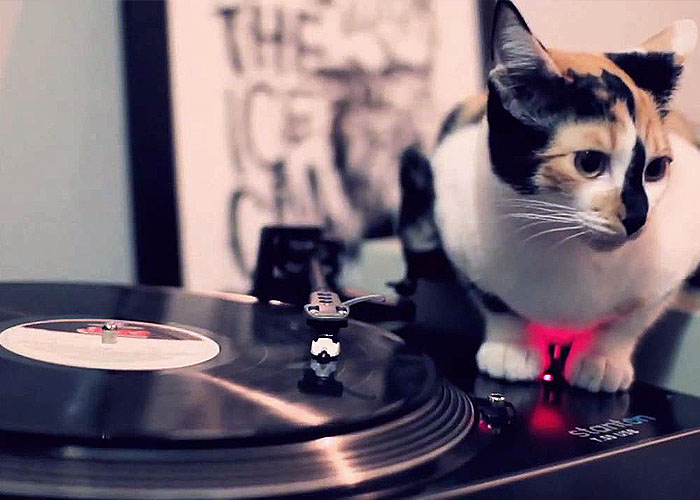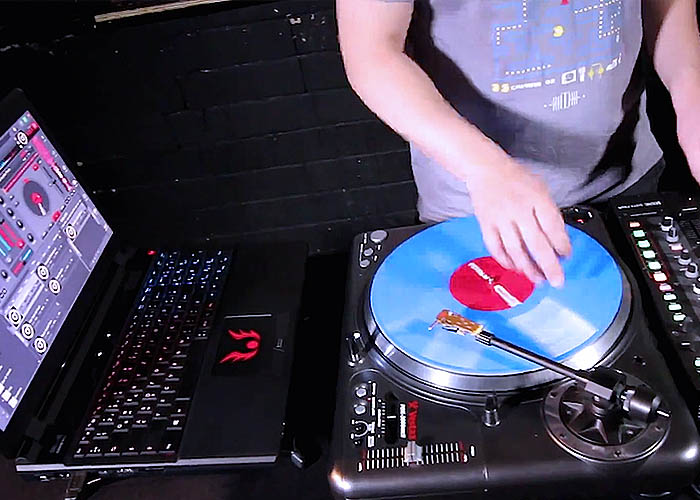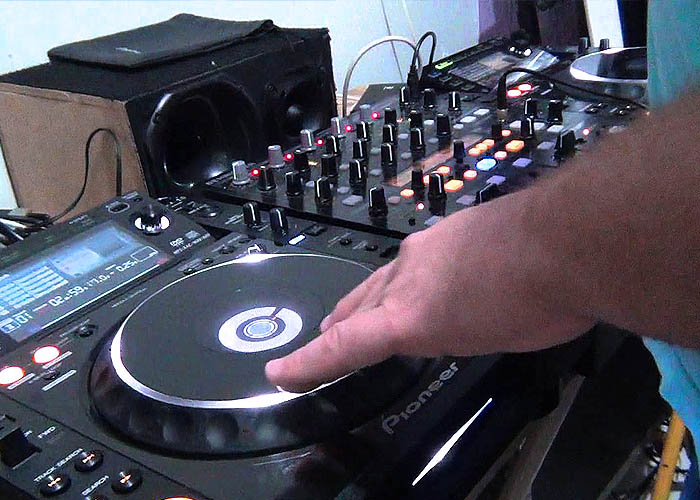
As a young lad I remember being scolded by my mom when I grabbed the spinning record on the turntable in our entertainment center. I saw DJs on TV who grabbed the record with ease and moved it back and forth to create the scratching sound. I thought it was that easy so I tried it myself. Before my mom booted me out of the entertainment center, I discovered that scratching wasn’t as simple as moving the record. There was an art to scratching and a difference between the forty year old belt driven turntable in my family’s entertainment center and the Technics the DJs were using on the TV. Today, there are multiple ways for DJs to spin tracks and there are also multiple ways for DJs to scratch. Thanks to improvements in DJ technology a DJ can scratch using a DVS system, CDJs, or even his MIDI controller. However, each one comes with it’s own personality that dictates how a DJ has to interact with the gear. This article will focus on how each system works and what a DJ should keep in mind before he grabs the deck.
Why and When to Scratch

A DJ can argue that scratching and turntablism are the foundations of DJing and that a DJ should be able (or at least know how) to perform a simple baby scratch. Since the mid-1970s DJs have been developing new ways to manipulate records without the assistance of any external effects. Today’s DJ culture is centered around sampling and effects. However scratching still has a rightful place in the DJ booth and a DJ should know how to perform a few scratches, even if the genre doesn’t traditionally allow scratching.
Here are some of my favorite scratches that were the easiest for me to learn when I started spinning music:
- Baby or Cut/Stab Scratch: This scratch is a simple one that I found the easiest to learn when I started DJing at the age of 11. Simply find a sample on the track that isn’t playing and get the needle right before the sample. Then, open the fader while the sample plays. After the sample comes through, close the fader while rewinding the track back to the beginning of the sample.
- Uzi Scratch: I had a lot of fun with this scratch as a kid and it is also really easy to overuse during a set. A DJ begins by finding a sample on a record that sounds in key to the track which is playing. Then, the DJ opens the fader while moving the record back and forth so quickly that the sample mimics the noise an Uzi machine gun makes. Then close the fader in a quick manner so that the scratch is only performed over a short period of time.
- Tear Scratch: The tear scratch is a bit more complicated than the baby scratch. Here the fader is always open but the record can move backwards or forwards as long as the movement has a short stop. The goal is to create three or more different sounds within the scratch.
The other important aspect of scratching in a set is knowing when to scratch. A budding DJ will have fun scratching over every second of a record however turntablism isn’t about just making the scratching sounds. Scratches are performed rhythmically and in time with the music. A DJ can scratch at any point in time during a set (at your creative discretion). Just remember that the scratch should be in time and key with the track. The reason is because listeners expect to hear the track normally played so scratches take them by surprise naturally. When a scratch is off beat or out of key, the listener will hear a clashing of sounds. However, the opposite catches the listener’s ear in a good way by providing them a new way to hear the track. Watch turntablist DJs such as Jazzy Jeff, Q-Bert, Shiftee, and others on YouTube to get a sense of how scratching is a rhythmic technique.
Scratching with a DVS System

The DVS system is the most common scratch system that DJs use today. Any DJ that says he is still using actual vinyl to DJ sets isn’t probably playing clubs or festivals. DVS stands for Digital Vinyl System and it was great for DJs who didn’t want to be left behind because of their love for vinyl. DVS systems typically come with a special soundcard that is made to read the signal that the control vinyl sends and interpret that signal with the digital track playing at the least amount of latency possible. The end result is having a digital track manipulated as if it were on a vinyl record. In my opinion, and most other DJs' opinions, this is the most authentic scratch a DJ can get with digital tracks. That being said, there are a few things to keep in mind when scratching with a DVS system.
- Get Your Laptop Up to Speed: With DVS systems a computer is doing double the workload to play the track. The computer has to listen for an additional signal (the control vinyl) from each deck on top of playing the track. Then, the computer has to follow the DJ’s manipulation patterns while also outputting a solid audio signal. That being said, make sure your laptop is made within the past five years or at least clean it out so that all the resources are going to your DJ software. Any DJ running Serato or Traktor Scratch with a processor less than an i5 and less than 4GB of RAM will be walking on a tightrope.
- MP3s Only Please: Piggybacking off the last comment, don’t use WAVs when using DVS. The computer is already doing a lot for you and adding a WAV is going to put even more stress on the processor. And, frankly, the club isn’t going to notice the difference between the 60MB WAV file and the 8MB MP3. Digital DJ Pool offers high quality MP3s that sound great and will scratch great, too.
- Re-teach Yourself the Scratches: While latency may not be a big deal to a controller DJ, a scratch DJ will find out that there is something off to scratching on a DVS system when compared to real vinyl. The difference here is latency which is the amount of time an action creates an output sound or action. Even the best scratch DJs come across latency issues with their super optimized sets. Go over all the scratches you know and find out how to adapt them for your DVS system. Given the state of the current technology most scratches that can be performed on traditional vinyl systems can be played on DVS systems.
- Keep Old School Practices: DVS systems still depend on vinyl, needles, and tonearms. Before every set, check that the control vinyl is in good condition, check that the needle is free of dust and debris, and be sure to properly weight your tonearm.
Scratching with CDJs

While having a pair of Technics and an awesome mixer as part of your setup is nice, it isn’t functional if you are a club DJ. Sure, you can use DVS to mix with CDJs, the club standard, but honestly who wants to be wasting all that time to get everything hooked up when you can just DJ and scratch using the CDJs as is? CDJs can be used for scratching and a recent video of A-Trak performing at Ultra confirms that fact. However there are some things to consider.
Scratch without Scratching: The CDJs are interesting pieces of equipment because they can actually be used to recreate scratch sounds without actually scratching with the platter. This is a quick and easy way to scratch if you need a little scratch in a pinch. Simply turn the master tempo of one of the CDJs you are using to scratch. Then, have the fader open to your liking and hit the cue button while moving the jog wheel back and forth in time with the beat. This makes the iconic scratch sounds while all you are actually doing is adjusting the tempo. Simple and easy.
When Actually Scratching: As a DJ though you want to show off your skills as a turntablist so there are a few things to know about actually scratching with the CDJs.
- The Infamous CDJ Drift: A common problem for most DJs is the CDJ drift that occurs when DJs try scratching at the beginning of a track. What essentially happens is that the position of the “needle” on the CDJ platter will drift causing a DJ to move her hand around the platter to stay in time. This is an annoying bug that has yet to have a reported fix from Pioneer but DJs can fix it themselves. In a tedious fashion, if every track that a DJ wants to scratch in the beginning of has two seconds of silence before the track starts, this alleviates the problem. However, that means: a) inserting the silence and b) putting the load point at the “real” beginning of the track. It may be easier just to find a sample that isn’t at the beginning of the track.
- Nitty Gritty Details: As with any scratch DJ’s mixer the crossfader needs to be adjusted accordingly to have the sharpest/fastest curve possible. I find most club mixers to be set to “X” instead of /---\ so check the settings before starting your set. Also, this is a given, but set the CDJ to vinyl mode to ensure that when touching the platter the CDJ acts like vinyl instead of just adjusting the master tempo.
- Get Used to Zero Resistance: The CDJ platters aren’t moving like turntable platters so when scratching there will be no resistance. This means that letting go of the platter and spinning a platter must be done with less force along with scratch patterns being less dramatic. If given the opportunity, practice some scratches on a pair of CDJs to see how you need to adapt in order to perform on a CDJ setup versus a vinyl setup. You can also check out a great video from Point Blank that demonstrates how one should scratch on CDJs.
Scratching with a MIDI Controller

The last option most DJs probably have to scratch is using their MIDI controllers. To be honest, the MIDI controller isn’t that bad of a tool to use to scratch. Sure, it isn’t vinyl but neither are CDJs or DVS. Yet, controllers can be pretty useful for scratch DJs if given the chance.
- Know Your Latency: Latency is the biggest issue for MIDI controllers because of all the audio routing and processes that the computer has to handle. That being said, practice your scratches heavily with the MIDI controller in question. What does a crab sound like? How about a chirp? You will begin to notice differences in the way you have to scratch (moving ahead of the beat or moving slower) and once those adjustments are made, scratching on a controller will be just as easy as on a vinyl setup.
- MP3s Only Please: I just want to re-iterate that WAVs are not necessary for most DJ environments, especially when scratching is involved. A playlist with 320 KBP MP3s will ensure that the computer can handle your scratches and that the music will sound prime.
- Purist vs. Realist: There are many DJs out there who will be quick to say that scratching using a controller isn’t the same because the jog wheels are too small, beat juggling is impossible with software visual cues, and for many other reasons. In reality, the controller is only really limiting in terms of the latency and the construction. Latency, as discussed, can be resolved with a clean, optimized computer. A $50 controller will be less productive than a $800 controller however scratching is still possible. The biggest (and most obvious) realization that needs to be made is that a controller setup is not a vinyl setup. Thus, a DJ should adapt to the setup and for most DJs growing up with controllers, there is no excuse for them not to learn how to scratch-especially not for the reason that controllers aren’t vinyl. Just make sure the fader is set to /---\ in the software and get started!
To Scratch or Not To Scratch: That Is the Question!

These are few tips on scratching that I gathered from years of personal experience and from fellow DJs. Scratching is the foundation of DJing today and even though most DJs forgo the art of scratching, there is still a lot of places where it can be done. From EDM to Hip-Hop, scratching is possible and, to be honest, it is one of the most fun things to do during a set. If you are looking for some scratch samples to use in a set or to practice with then be sure to check out the Sound FX section of the pool for our collection of high quality samples.

Dean William can be found gallivanting about the clubs of San Francisco. He's on Twitter: @deanithon.




DJ Chief 10/25/2015 12:42 PM
A Big Salute.. Thanks.